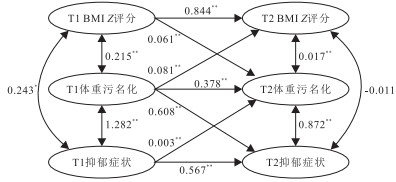Longitudinal cross-lagged analysis of body mass index and weight stigma with depressive symptom in adolescents
-
摘要:
目的 探讨青少年体质量指数(BMI)Z评分、体重污名化与抑郁症状之间的双向作用机制,为制定针对性的干预措施提供依据。 方法 采用分层整群随机抽样方法,于2023年9月(T1)和2024年9月(T2)从内蒙古自治区全部12个盟市(103个旗县区)抽取18 301名12~18岁青少年开展2次纵向调查。通过自编问卷评估体重污名化,采用流调中心抑郁量表(CES-D)测量抑郁症状,并依据世界卫生组织标准计算BMI Z评分。采用Pearson相关分析变量的相关性,构建交叉滞后面板模型考察三变量之间的动态双向关系。 结果 青少年BMI Z评分、体重污名化与抑郁症状在两个时间点之间均表现出自相关性(自回归路径P值均 < 0.01)。交叉滞后模型结果显示,双向路径模型拟合最佳(χ2=12.65,RMSEA=0.017,CFI=1.000;△χ2=193.39,P < 0.01),支持三变量之间的动态双向作用机制。调整性别、年龄、主观社会地位和是否为独生子女变量后,青少年T1 BMI Z评分正向预测T2体重污名化(β=0.061)、T1体重污名化正向预测T2抑郁症状(β=0.608);反向路径分析显示,青少年T1抑郁症状可预测T2体重污名化(β=0.003)、T1体重污名化可预测T2 BMI Z评分(β=0.081)(P值均 < 0.01)。 结论 青少年BMI Z评分、体重污名化与抑郁症状之间存在双向交叉滞后关系,体重污名化可能是连接肥胖与抑郁症状的关键变量。应重视体重污名化对青少年心理健康的潜在威胁,推动干预策略从生理指标延伸至社会心理层面。 Abstract:Objective To explore the bidirectional associations among body mass index Z-scores (BMI Z-scores) and weight stigma with depressive symptoms in adolescents, thereby providing evidence for targeted intervention strategies. Methods A stratified cluster random sampling method was employed to select 18 301 adolescents aged 12-18 years from all 12 prefectures (103 counties) in the Inner Mongolia Autonomous Region, and two waves of longitudinal surveys were conducted in September 2023 (T1) and September 2024 (T2) among the adolescents. Weight stigma was assessed by using a self-developed questionnaire, depressive symptom was measured with the Center for Epidemiologic Studies Depression Scale (CES-D), and BMI Z-scores were calculated according to the World Health Organization standards. Pearson correlation analysis was used to examine associations among variables, and cross-lagged panel models were constructed to investigate the dynamic bidirectional relationships among the three variables. Results Adolescents' BMI Z-scores and weight stigma with depressive symptoms all exhibited autoregressive stability across the two time points (autoregressive paths, all P < 0.01). Cross-lagged model comparisons indicated that the bidirectional path model achieved the best fit (χ2=12.65, RMSEA=0.017, CFI=1.000; △χ2=193.39, P < 0.01), supporting dynamic bidirectional associations among the three variables. After adjusting for gender, age, subjective social status and only-child status, T1 BMI Z-scores among adolescents positively predicted T2 weight stigma (β=0.061), and T1 weight stigma positively predicted T2 depressive symptoms (β=0.608); in the reverse direction, T1 depressive symptoms predicted T2 weight stigma (β=0.003), and T1 weight stigma predicted T2 BMI Z-scores (β=0.081) (all P < 0.01). Conclusions There is a bidirectional cross-lagged relationship among adolescents' BMI Z-scores and weight stigma with depressive symptoms, suggesting that weight stigma may serve as a key psychological variable linking obesity and depressive symptoms. Greater attention should be paid to the potential threat of weight stigma to adolescents' mental health, with intervention strategies expanded from a solely physiological focus to encompass psychosocial dimensions. -
Key words:
- Body mass index /
- Depression /
- Mental health /
- Cross-lagged analysis /
- Adolescent
1) 利益冲突声明 所有作者声明无利益冲突。 -
表 1 T1不同组别青少年BMI Z评分、体重污名化和抑郁症状评分比较(x ±s)
Table 1. Comparison of BMI Z, weight stigma and depressive sy- mptoms scores among adolescents with different groups at T1(x ±s)
组别 人数 统计值 BMI Z 体重污名化 抑郁症状 性别 男 7 461 0.69±1.44 0.15±0.47 10.88±9.90 女 10 840 0.42±1.19 0.19±0.53 11.84±10.27 t值 13.40 -5.12 -6.31 P值 < 0.01 < 0.01 < 0.01 年龄/岁 12~13 9 391 0.63±1.31 0.14±0.46 10.24±9.55 14~15 4 693 0.47±1.29 0.19±0.54 12.21±10.55 16~18 4 217 0.38±1.29 0.21±0.56 13.28±10.55 F值 61.20 26.52 150.86 P值 < 0.01 < 0.01 < 0.01 主观社会地位/分 0~3 2 579 0.51±1.31 0.22±0.57 14.75±12.03 4~6 12 622 0.52±1.31 0.16±0.50 11.05±9.63 7~10 3 100 0.58±1.29 0.17±0.52 10.33±9.84 F值 2.77 13.69 169.03 P值 0.06 < 0.01 < 0.01 是否独生子女 是 7 170 0.63±1.35 0.17±0.52 11.07±10.18 否 11 131 0.46±1.28 0.17±0.50 11.69±10.10 t值 8.28 0.65 -4.03 P值 < 0.01 0.51 < 0.01 -
[1] GBD 2021 Adolescent BMI Collaborators. Global, regional, and national prevalence of child and adolescent overweight and obesity, 1990-2021, with forecasts to 2050: a forecasting study for the Global Burden of Disease Study 2021[J]. Lancet, 2025, 405(10481): 785-812. doi: 10.1016/S0140-6736(25)00397-6 [2] RUBINO F, PUHL R M, CUMMINGS D E, et al. Joint international consensus statement for ending stigma of obesity[J]. Nat Med, 2020, 26(4): 485-497. doi: 10.1038/s41591-020-0803-x [3] PUHL R M, HEUER C A. Obesity stigma: important considerations for public health[J]. Am J Public Health, 2010, 100(6): 1019-1028. doi: 10.2105/AJPH.2009.159491 [4] LEE K M, WANG C, DU H, et al. Weight stigma as a stressor: a preliminary multi-wave, longitudinal study testing the biobehavioral pathways of the cyclic obesity/weight-based stigma (cobwebs) model[J]. Appetite, 2024, 201: 107573. doi: 10.1016/j.appet.2024.107573 [5] EMMER C, BOSNJAK M, MATA J. The association between weight stigma and mental health: a Meta-analysis[J]. Obes Rev, 2020, 21(1): e12935. doi: 10.1111/obr.12935 [6] 段文杰, 冯宇. 体重污名: 对肥胖的歧视与偏见[J]. 心理科学进展, 2018, 26(6): 1074-1082.DUAN W J, FENG Y. Weight stigma: discrimination and bias against obesity[J]. Adv Psychol Sci, 2018, 26(6): 1074-1082. (in Chinese) [7] PUHL R M, HIMMELSTEIN M S, PEARL R L. Weight stigma as a psychosocial contributor to obesity[J]. Am Psychol, 2020, 75(2): 274-289. doi: 10.1037/amp0000538 [8] PONT S J, PUHL R, COOK S R, et al. Stigma experienced by children and adolescents with obesity[J]. Pediatrics, 2017, 140(6): e20173034. doi: 10.1542/peds.2017-3034 [9] MANNAN M, MAMUN A, DOIS, et al. Prospective associations between depression and obesity for adolescent males and females: a systematic review and Meta-analysis of longitudinal studies[J]. PLoS One, 2016, 11(6): e0157240. doi: 10.1371/journal.pone.0157240 [10] ADLER N E, EPEL E S, CASTELLAZZO G, et al. Relationship of subjective and objective social status with psychological and physiological functioning: preliminary data in healthy white women[J]. Health Psychol, 2000, 19(6): 586-592. doi: 10.1037/0278-6133.19.6.586 [11] ONIS M, ONYANGO A W, BORGHI E, et al. Development of a WHO growth reference for school-aged children and adolescents[J]. Bull World Health Organ, 2007, 85(9): 660-667. doi: 10.2471/BLT.07.043497 [12] THOMPSON J K, CATTARIN J, FOWLER B, et al. The Perception of Teasing Scale(POTS): a revision and extension of the Physical Appearance Related Teasing Scale(PARTS)[J]. J Pers Assess, 1995, 65(1): 146-157. doi: 10.1207/s15327752jpa6501_11 [13] RADLOFF L S. The CES-D Scale: a self-report depression scale for research in the general population[J]. Appl Psychol Meas, 1977, 1(3): 385-401. doi: 10.1177/014662167700100306 [14] LATNER J D, STUNKARD A J. Getting worse: the stigmatization of obese children[J]. Obes Res, 2003, 11(3): 452-456. doi: 10.1038/oby.2003.61 [15] PUHL R M, KING K M. Weight discrimination and bullying[J]. Best Pract Res Clin Endocrinol Metab, 2013, 27(2): 117-127. doi: 10.1016/j.beem.2012.12.002 [16] HAINES J, NEUMARK-SZTAINER D. Prevention of obesity and eating disorders: a consideration of shared risk factors[J]. Health Educ Res, 2006, 21(6): 770-782. doi: 10.1093/her/cyl094 [17] GOLDEN N H, SCHNEIDER M, WOOD C. Preventing obesity and eating disorders in adolescents[J]. Pediatrics, 2016, 138(3): e20161649. doi: 10.1542/peds.2016-1649 [18] PEARL R L, WHITE M A, GRILO C M. Weight bias internalization, depression, and self-reported health among overweight binge eating disorder patients[J]. Obesity, 2014, 22(5): E142-E148. [19] 马彩霞, 马军, 宋逸, 等. 内蒙古地区学生超重肥胖与抑郁共患影响因素分析[J]. 中国学校卫生, 2023, 44(9): 1308-1312, 1318. doi: 10.16835/j.cnki.1000-9817.2023.09.007 MA C X, MA J, SONG Y, et al. Co-morbidity of overweight, obesity and depression and its influencing factors among students in Inner Mongolia Autonomous Region[J]. Chin J Sch Health, 2023, 44(9): 1308-1312, 1318. (in Chinese) doi: 10.16835/j.cnki.1000-9817.2023.09.007 [20] TOMIYAMA A J. Weight stigma is stressful. A review of evidence for the cyclic obesity/weight-based stigma model[J]. Appetite, 2014, 82: 8-15. doi: 10.1016/j.appet.2014.06.108 [21] FREDERICK D A, SAGUY A C, SANDHU G, et al. Effects of competing news media frames of weight on antifat stigma, beliefs about weight and support for obesity-related public policies[J]. Int J Obes, 2016, 40(3): 543-549. doi: 10.1038/ijo.2015.195 [22] ZOU R, XU X, HONG X, et al. Higher socioeconomic status predicts less risk of depression in adolescence: serial mediating roles of social support and optimism[J]. Front Psychol, 2020(11): 1955. -







 下载:
下载:

